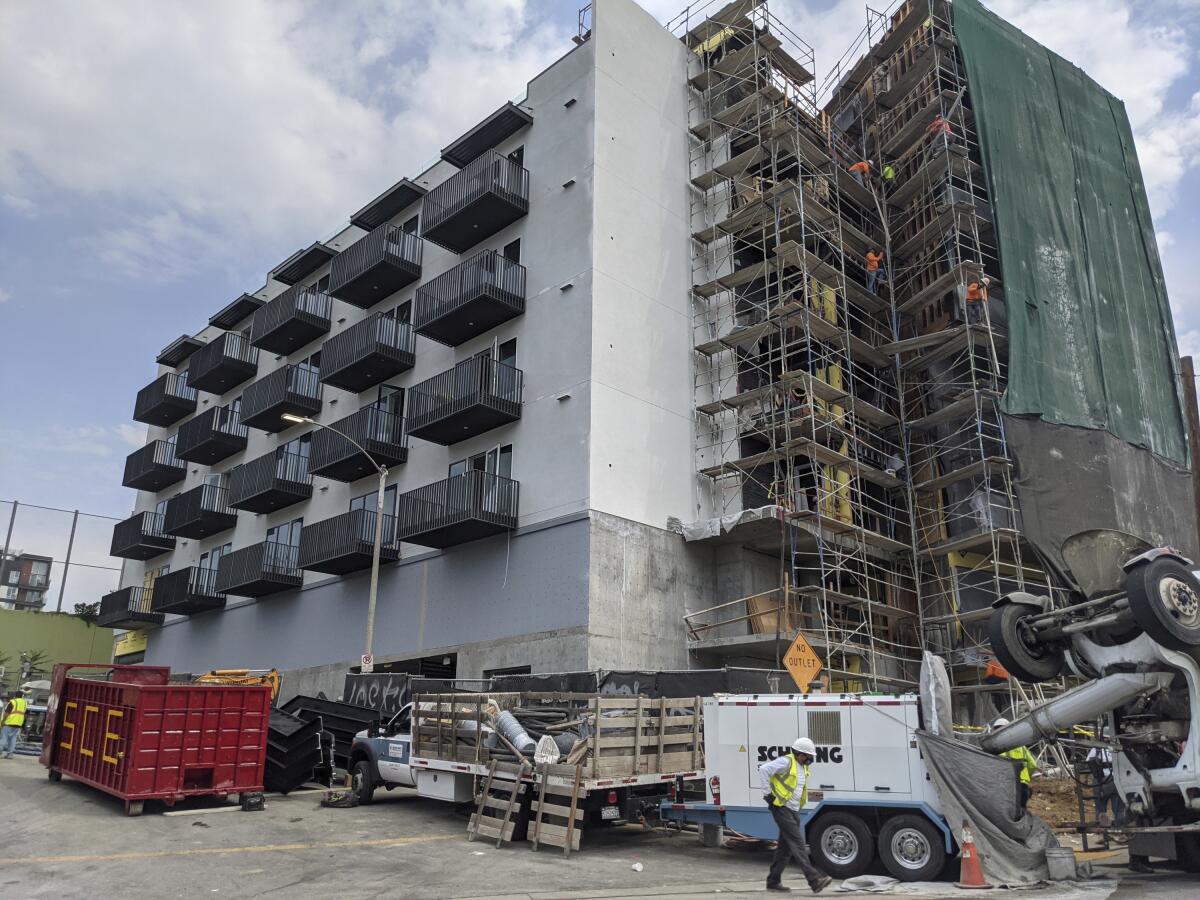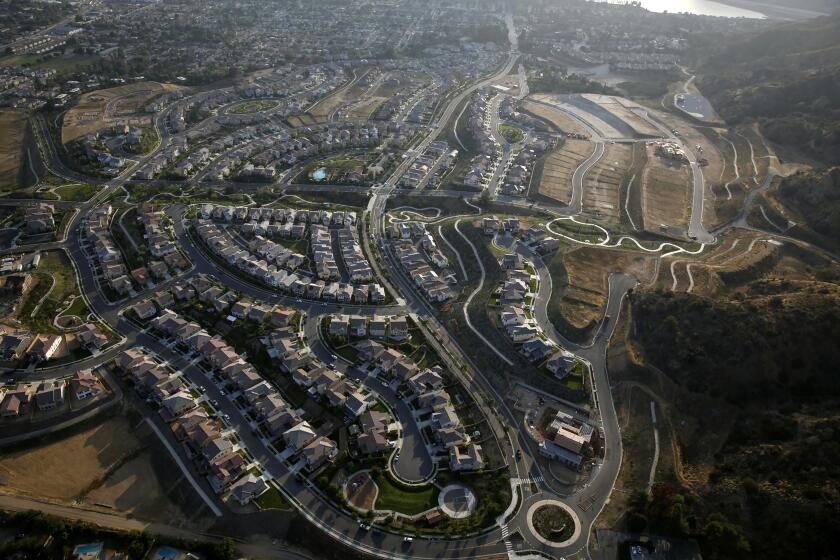Don’t be fooled: California’s new housing laws make significant changes to zoning

- Share via
SACRAMENTO — The word is out that major land zoning bills signed by Gov. Gavin Newsom don’t amount to much because they were so watered down by compromising legislators. Don’t believe it.
If my next-door neighbor can convert her single-family home into a fourplex, that amounts to a lot. Suddenly there are more cars parked on the street, more little kids screaming and more dogs leaving gifts on my lawn.
And she could do that under SB 9, the signature bill by Senate leader Toni Atkins (D-San Diego) from the recently concluded legislative session.
Not that the legislation shouldn’t have been passed and signed. California’s urban areas must become more densely populated if we’re to provide enough affordable housing for 40 million-plus people.
We’re still clinging to the comfortable California ranch-house lifestyle — founded on sunshine and ample backyard space for a pool — that we became accustomed to in the last century when our population was half or one-quarter what it is today.
But living space has greatly tightened, and housing has become impossibly pricey for too many middle-class families and young couples who are being priced out of California.
We need to cozy up in the larger cities near jobs and public transportation. That means filling in vacant lots with housing, making more efficient use of residential land and building higher rather than sideways into far-off suburbia, where long commutes play havoc with family life and emit greenhouse gases that accelerate climate change.
But mainly, we’ve got to do something about the economics of supply and demand that are turning the California dream into a nightmare for millions. There’s a dearth of supply and unquenchable demand. We need to add 1.8 million to 2.5 million new homes by 2025, and we’re crawling along at maybe 100,000 per year.
California Gov. Gavin Newsom has approved two measures to slice through local zoning ordinances as the most populous state struggles with an affordable housing shortage.
The median price of a single-family California home in August was about $828,000, compared with the national median of roughly $360,000 in July. In Los Angeles, it was $825,000 in July — in the San Francisco Bay Area, $1.3 million.
The Times on Tuesday reported that there are 55 cities in L.A. and Orange counties where the typical value of a single-family home is $1 million or more.
So, I should bear that in mind when I grouse — for personal and justifiable reasons — about the prospect of a fourplex being erected next door.
Atkins’ bill and another, SB 10 by Sen. Scott Wiener (D-San Francisco), would weaken single-family zoning — if not eliminate it — and make it easier to build multifamily dwellings.
“I ask people who are opposed to these bills: ‘What about how the status quo is working now? What about our affordability crisis, soaring home prices, homeless crisis? Is that OK with you?’” says Jason Elliott, a Newsom senior advisor.
“It’s difficult if not impossible for young people to even think about buying a house. The status quo on affordability is broken. When the status quo isn’t working, it demands change.
“California needs more housing, especially in the right places — near jobs, schools, parks, shopping centers, transportation. This legislation is a lot better for our climate and moves us towards the governor’s equity and affordability goals.”
Gov. Gavin Newsom signed legislation that allows more than one unit to be built on lots zoned for only one. It sounds technical, but it’s a major change in California housing policy. Here’s what it means.
SB 9, dubbed the “duplex bill,” would offer homeowners new options to build additional housing on their lots, regardless of whether they’re currently zoned for single-family only. They could add a granny flat, convert the house into a duplex or erect a triplex or fourplex.
SB 10 would be voluntary for cities. They could rezone a parcel for a new housing development of up to 10 units and streamline government permitting. A builder could bypass the California Environmental Quality Act, often abused by a project’s opponents. The project gets dragged out until it’s no longer economically feasible and is abandoned.
“Instead of taking 10 years, a project could be permitted in a matter of months,” Wiener says.
Both bills — especially the duplex bill — triggered an intense legislative fight, most of it under the news media radar because of attention given to the Newsom recall election and pandemic.
“It was a good old-fashioned political showdown,” Wiener says.
The showdown was unique for a legislative battle. It involved mainly ordinary citizens, especially on the opposition side, much more than special interests.
The battle also was unique for another reason. It was less about partisanship than geography — where a lawmaker lived mattered more than party.
A lot of homeowners and some wannabe homeowners priced out of the market followed the old textbook advice to “write and call your legislator.”
“The NIMBYs fought very hard,” says Wiener, referring to local Not-in-My-Backyard coalitions. “They’ve gotten organized — and loud. But there were grass-roots advocates on both sides. Younger people who can’t afford single-family homes have gotten very organized and large.”
The most intense tussle was over local control, with dozens of cities — including L.A. — opposing the legislation.
“Local government has less control under these bills,” says Sacramento Mayor Darrell Steinberg, a former leader of the state Senate. As a legislator, Steinberg pushed through some of the earliest legislation that attempted to incentivize more urban housing near public transportation.
“I’ve been on both sides. My view has not changed. Local control is an important value, but it’s not absolute. It’s not more important than the desperate need in this state to produce more housing.”
In the end, several protections were negotiated into Atkins’ bill to preserve rental and low-income housing, deter speculators and retain local government control over design standards.
Converting single-family houses into duplexes or fourplexes could occur only in urban areas.
I just don’t want a fourplex next door to me. But I also want my grandkids to be able to afford to live in California.
Newsom and the Legislature showed courage in siding with my grandkids.
More to Read
Sign up for Essential California
The most important California stories and recommendations in your inbox every morning.
You may occasionally receive promotional content from the Los Angeles Times.
















